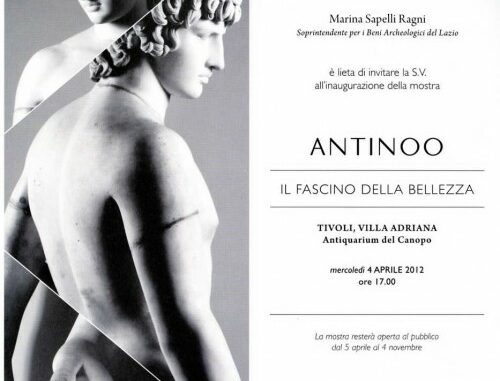
For the first time, the Superintendence for Archaeological Heritage of Latium Villa Adriana Antiquarium opens an exhibition dedicated to Antinous. Fifty works including sculptures, reliefs, gems and coins tell the strong ties that bound the Emperor Hadrian to the young Bithynian youth.
The exhibition will be accompanied by a catalog published by Electa, the first Italian-date monograph, which reconstructs the figure of ancient history and the seductiveness of the taste.
In memory of Antinous, the beautiful, young, lover of Hadrian, who he met in Bithynia, and brought with him to Rome, Hadrian built the Antinoeion. It came to light in excavations conducted by the Superintendent between 2002 and 2005, when it was recognized as the tomb-temple designed to honor Antinous’ memory.
On the occasion of the exhibition, there will be a walk presented to visit the archaeological remains of the Antinoeion. Currently, they are legible and the perimeter of the site. Present are the large exedra, fronted by two separate temples and an obelisk, which today is on the ‘Pincio’, the terrace where you can see all of Rome. The buildings were richly decorated with animals, sculptures, and Egyptian bas-reliefs, some of them exhibited on this occasion.
The exhibition is divided into four sections, which display works from different museums and collections. The selection was intended to favor the return to Villa Adriana the remains that there definitely, or probably, were found there.
The first section includes a series of Hadrian’s and Antinous’ portraits , including the marble bust of the Vatican Museums and the beautiful bronze from the Archaeological Museum of Florence.
The second section focuses on the deification of the young ‘bitinio’, from time to time represented as Apollo, Dionysus, or even as a priest of Attis.
The third section focuses on the recent discoveries of the dall’Antinoeion of the Villa Adriana and, therefore, the representation of Antinous in the guise of Osiris. Hadrian had deified his favorite assimilation with the highest Egyptian God who, according to myth, rise from the waters of the Nile, a symbol of fertility. In the exhibition you can admire the breathtaking portrait of Antinous-Osiris of red quartzite, thanks to the loan from the Staatliche Kunstsammlungen in Dresden.
The last section focuses on luck of Antinous through the centuries. Among the loans you can admire one of the precious volumes of the “Viaggio pittorico di Villa Adriana ” (Journey painting of Villa Adriana) by Agostino Penna of 1831 – 36, which contains a beautiful portrait of Antinous, now located in the Vatican Museums, in the Sala della Rotonda.
Opening of the Exhibition Wednesday, April 4 at 17.00.
Open from April 5 to November 4, 2012
Villa Adriana, Tivoli Largo Marguerite Yourcenar 1
Information and reservations 06 39967900
Fabio Chiarini


Congratulations on reporting the curating of such an important assembly of works portraying a key personage at Hadrian’s original Villa at Tivoli/Tibur :- Hadrian’s lover Antinous (d.130CE).
However, in listing Margeurite Yourcenar’s novel MEMOIRS OF HADRIAN (France 1950), the FABIOC press release excludes two new fiction works about Hadrian and Antinous : THE HADRIAN ENIGMA (G. Gardiner 2010) and EROMENOS (M. McDonald 2011).
Hi, George! I just finished reading your ENIGMA, right after reading EROMENOS, and I must say that I find your rendition much closer to the truth, as I perceive it to be, of Hadrian and Antinous’s relationship. Whether the Bithynian beauty was the victim of a byzantine murder plot, as you suggest, or the willing perpetrator of his own premature death by self-sacrifice, the love they shared shines down through the centuries in this amazing young man’s alluring marble likeness, and speaks to us of Hadrian’s deep devotion. While it’s true that the Romans had no conception of homosexuality as we conceive of it, the lack of such a term in Latin for this proclivity does not mean that the exclusive preference for one’s own sex did not exist among men back then (even amongst macho ones, as these two clearly were). And I think the record, scant as it is, amply suggests that Hadrian and Antinous saw themselves, behind closed doors, linked in a committed relationship that both of them wanted to perpetuate–perhaps all too desperately–well into Antinous’s mature years. Had they lived in a different era, I’ve little doubt they would’ve been coupled for life, and had they lived in contemporary Boston, they would likely have exchanged vows!
Hooray for Villa Adriana for finally loudly acclaiming the uniqueness of this union between two men whose ardent love for each other, expressed spiritually, emotionally and physically, survives antiquity as does no other. I live in London and will attend the exhibition in October. Although I’ve seen many of these works in major museums worldwide, there are a few I’ve missed along the way, and I cannot wait to view them all amassed under one roof. This is a stroke of marketing genius!
Now. All that remains is for someone to make a movie about these two. I predict it would be a blockbuster!